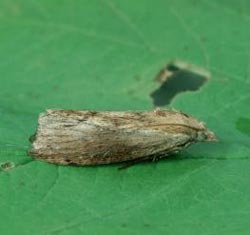Researchers discover world's most extreme hearing animal

This is the greater wax moth.<br>Credit: Ian Kimber<br>
Humans are only capable of hearing sounds of 20kHz maximum, dropping to around 12-15kHz as we age, and even dolphins, known exponents of ultrasound, can't compete as their limitations are around 160kHz.
The research, conducted at the University's Centre for Ultrasonic Engineering, has identified the extraordinary sensory characteristics of the moth, paving the way for developments in air-couple ultrasound.
Dr James Windmill, who has led the research at Strathclyde, said: “We are extremely surprised to find that the moth is capable of hearing sound frequencies at this level and we hope to use the findings to better understand air-coupled ultrasound.”
“The use of ultrasound in air is extremely difficult as such high frequency signals are quickly weakened in air. Other animals such as bats are known to use ultrasound to communicate and now it is clear that moths are capable of even more advanced use of sound.
“It's not entirely clear how the moths have developed to be able to hear at such a high frequency, but it is possible that they have had to improve the communication between each other to avoid capture from their natural predator – the bat – which use similar sounds.”
The research findings will allow the Dr Windmill and his colleagues to further develop their understanding of ultrasound and how to transmit and receive ultrasonic pulses travelling in air.
With frequency sensitivity that is unparalleled in the animal kingdom, this moth is ready for any echolocation call adaptations made by the bat in the on-going bat–moth evolutionary war.
Dr Windmill's multi-disciplinary research team is now working to apply the biological study of this, and other insect ears to the design of micro-scale acoustic systems. It is hoped that by studying the unprecedented capabilities of the moth's ear, the team can produce new technological innovations, such as miniature microphones.
Published paper in Royal Society journal Biology Letters: Moir HM, Jackson JC, Windmill JFC. 2013 Extremely high frequency sensitivity in a 'simple' ear. Biol Lett 20130241.
Media Contact
More Information:
http://www.strath.ac.ukAll latest news from the category: Life Sciences and Chemistry
Articles and reports from the Life Sciences and chemistry area deal with applied and basic research into modern biology, chemistry and human medicine.
Valuable information can be found on a range of life sciences fields including bacteriology, biochemistry, bionics, bioinformatics, biophysics, biotechnology, genetics, geobotany, human biology, marine biology, microbiology, molecular biology, cellular biology, zoology, bioinorganic chemistry, microchemistry and environmental chemistry.
Newest articles

High-energy-density aqueous battery based on halogen multi-electron transfer
Traditional non-aqueous lithium-ion batteries have a high energy density, but their safety is compromised due to the flammable organic electrolytes they utilize. Aqueous batteries use water as the solvent for…

First-ever combined heart pump and pig kidney transplant
…gives new hope to patient with terminal illness. Surgeons at NYU Langone Health performed the first-ever combined mechanical heart pump and gene-edited pig kidney transplant surgery in a 54-year-old woman…

Biophysics: Testing how well biomarkers work
LMU researchers have developed a method to determine how reliably target proteins can be labeled using super-resolution fluorescence microscopy. Modern microscopy techniques make it possible to examine the inner workings…





















